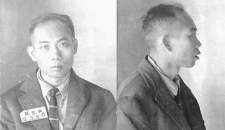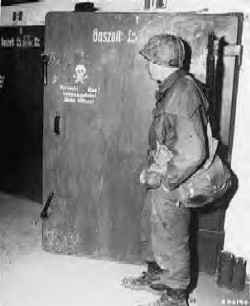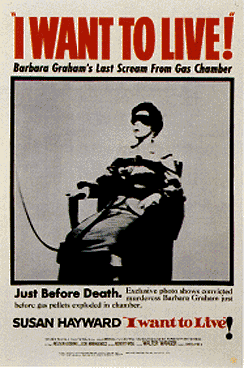|
Gas Chamber When citizens go astray, society responds with punishment. When citizens go really, really astray, the punishment is the ultimate—death.
When citizens go astray, society responds with punishment. When citizens go really, really astray, the punishment is the ultimate—death. But death can be an ugly business, as readers of Rotten.com know all too well. Over the course of centuries, executioners have sought ways to put a presentable face on an ugly process. Falling between the electric chair and lethal injection, the gas chamber was an American innovation. Before the 20th Century, The American Way consisted of either shooting people or hanging them. Neither method was particularly tidy, especially hanging, which had a tendency to get out of hand. If everything wasn't just perfect, a victim could take hours to strangle to death. If you made an error in the other direction, their heads could rip off. Cyanide gas had been used as a pesticide during the 19th century, and several states began examining its use for execution. Nevada and Arizona were neck-and-neck in the race to execute the first inmate with gas, but Nevada won out in a photo finish. The first American to go under the gas was Gee Jon, a Chinese immigrant accused of a gang-related slaying. Initially, the plan was to pump poison gas into his jail cell while he slept, but the gas dissipated and Jon remained inconveniently alive.
Unfortunately, one execution does not represent a scientific sampling of the method's effectiveness. In part, the humaneness of the gas chamber depends on the cooperation of its victims. Cyanide gas can be a very humane way to kill someone, as long as they aren't fighting it. When an inmate chose to resist, however, things could get pretty ugly, and the biological imperative to stay alive is no small thing. A more typical gas chamber execution involved the inmate attempting to hold his or her breath and struggling against his or her bonds. It's one thing to hold your breath as part of a temper tantrum; it's quite another to hold your breath when your life literally depends on it. Over the years, witnesses saw the chamber's inmates turn various shades of red, blue and purple while trying not to breathe. Many were wracked with convulsions. Their faces became hideously contorted, either from horror or as a result of seizures induced by the gas shortly before death. (Eventually, some states began hooding prisoners to spare the witnesses this sight.) Inmates sometimes foamed at the mouth, or soiled themselves. In a precedent-setting Supreme Court case on whether the gas chamber was "cruel and unusual," a doctor from Johns Hopkins University offered the following description of what the gas chamber experience is like:
Other witnesses in the case provided more colorful accounts: The pellets of cyanide were released by mechanical controls, and dropped into an acid jar beneath the chair. The gas rose, and seemed to hit him immediately. Within the first minute, [he] slumped down. I thought to myself how quickly cyanide really worked. Within 30 seconds he lifted his head upwards again. He raised his entire body, arching, tugging at his straps. Saliva was oozing from his mouth. His eyes open, he turned his head to the right. He gazed through my window. His fingers were tightly gripping his thumbs. His chest was visibly heaving in sickening agony. Then he tilted his head higher, and rolled his eyes upward. Then he slumped forward. Still his heart was beating. It continued for another several minutes. Nevertheless, the gas chamber took on a certain cachet going into the 1930s. The efficiency of the method appealed to Adolf Hitler. At first, the Nazis simply rounded up Jews (as well as the disabled, Gypsies, homosexuals and other "subversives") and shot them. But efficiency was one of the Third Reich's claims to fame, and they soon realized that gas could be used to execute several people at once, with little mess and without the victims even knowing what was happening.
Auschwitz used mostly cyanide-based gases (in combination with other pesticides). Other camps used carbon monoxide exhaust fumes to suffocate their victims. The discovery of Nazi death factories after World War II took some of the luster away from the humanity of the gas chamber, but the real problem was the vomiting, spasms and contortions. Officials and witnesses to executions began to increasingly suspect that poison gas was not as quick and painless as initially thought. As if the Nazi taint wasn't bad enough, a series of high-profile gassings gone bad provided more grist for the mill. In one case, a severely disabled killer worked his hands free from the chair, screaming loudly as he tried to bat the gas away. Another inmate slit his own throat just before being taken to the chamber; the guards strapped him down and gassed him anyway.
Graham's case attracted a fair amount of attention, because of her gender, an unhappy childhood and the fact that she was (somewhat improbably) accused of pistol-whipping an elderly woman to death. (She would have been eligible for the death penalty even if one of the men had done the deed, but it's debatable whether she would have received such a sentence without the allegation against her.) Graham's story was loosely adapted into an anti-death penalty movie called I Want To Live!, which did present a pretty accurate picture of a trip to the gas chamber. Graham's story was part of a rising tide against the death penalty in general. Another inmate who ended in the gas chamber, Caryl Chessman, created a huge wave of sentiment against capital punishment by embarking on an aggressive P.R. campaign from death row.
During more than 10 years on death row, his execution was stayed eight times, and he wrote four popular book-length accounts of his own innocence, including Cell 2455: Death Row, a best-seller later adapted into a movie. Chessman claimed he knew the real identity of the kidnapper but said his loved ones had been threatened with retribution if he disclosed the name. A rainbow coalition of celebrities (from Aldous Huxley to Billy Graham) petitioned for Chessman's sentence to be commuted, but he went to the chamber in 1960. As Chessman was led into the gas chamber, he issued a final declaration that he was innocent of the crimes for which he was being executed. A possibly apocryphal story states that the governor's secretary attempted to call with a ninth stay of execution based on new evidence, but she misdialed the number on her first try, and the gas had already begun to flow.
The tide of public opinion was turning sharply against the death penalty by the mid-1960s. Between 1967 and 1977, a combination of public opinion and court rulings brought executions in the U.S. to a virtual standstill. When executions resumed, it was at a slower pace and with new methods. Lethal injection emerged as the method of choice, replacing such "humane" methods as the gas chamber and the electric chair. Today, the gas chamber has been almost entirely abandoned due to concerns about cruelty as well as the safety of the executioners. Almost all of the remaining gas chambers were built before the 1950s, and few have been carefully maintained since the 1970s, resulting in a high risk of gas leakage and other malfunctions. Between 1977 and 2003, only 11 inmates have been killed in the gas chamber, out of a total of 885 executions. One of those was Robert Alton Harris, executed in California in 1992, his last words quoting Bill and Ted's Bogus Journey. The very last man executed in the gas chamber was German-born Walter LeGrande, who was executed in Arizona in 1999. The execution was held in violation of international law (regarding consular notification before the execution of foreign nationals) and in defiance of an emergency stay order issued by the World Court. The gas chamber remains on the books in five of the U.S. states where it had been previously used; most of these laws are grandfather clauses allowing people to opt for the gas chamber if they were arrested prior to the passage of legislation rescinding the method of execution. Any further gas chamber executions will likely be requested by prospective corpses who wish to protest capital punishment by dying ugly, and even those will likely peter out completely over the next 10 or 20 years. The U.S. remains the only country with laws permitting gas chambers still on the books, although reports occasionally surface regarding off-the-books atrocities such as North Korea's "Camp 22," allegedly a concentration camp installation where women and children are routinely gassed to death. However, recent reports suggest that the tale of Camp 22 may have been based on forged documents, possibly brought to you by the same folks who gave you Iraqi WMDs, and possibly for the same reason. Don't worry, the truth will come out... probably no more than two years after the U.S. invades.
|
 Plan B was quickly implemented—the construction of a sealed chamber to keep the gas and the inmate all in one place until the end came. Inside the chamber, a bucket of sulfuric acid rests below the chair to which the inmate is strapped. The executioner throws a switch, which drops crystallized cyanide into the acid. As the crystals dissolve, poison gas is released into the air. Death typically takes less than 20 minutes.
Plan B was quickly implemented—the construction of a sealed chamber to keep the gas and the inmate all in one place until the end came. Inside the chamber, a bucket of sulfuric acid rests below the chair to which the inmate is strapped. The executioner throws a switch, which drops crystallized cyanide into the acid. As the crystals dissolve, poison gas is released into the air. Death typically takes less than 20 minutes.
 The person exposed to this gas remains conscious for a period of time, in some cases for several minutes, again depending on the rate and volume of the gas that is inhaled. During this time, the person is unquestionably experiencing pain and extreme anxiety. The pain begins immediately, and is felt in the arms, shoulders, back, and chest. The sensation is similar to the pain felt by a person during a heart attack, where essentially, the heart is being deprived of oxygen. The severity of the pain varies directly with the diminishing oxygen reaching the tissues.
The person exposed to this gas remains conscious for a period of time, in some cases for several minutes, again depending on the rate and volume of the gas that is inhaled. During this time, the person is unquestionably experiencing pain and extreme anxiety. The pain begins immediately, and is felt in the arms, shoulders, back, and chest. The sensation is similar to the pain felt by a person during a heart attack, where essentially, the heart is being deprived of oxygen. The severity of the pain varies directly with the diminishing oxygen reaching the tissues.
 The Nazi gas chambers began operating in 1941 and continued through 1944. More than 1 million Jews were estimated to have been gassed at
The Nazi gas chambers began operating in 1941 and continued through 1944. More than 1 million Jews were estimated to have been gassed at  Several individual cases also raised doubts for many. Barbara Graham, a woman of "low moral character," was executed in the California gas chamber. An elderly woman had been beaten and suffocated during a jewelry theft by Graham and three male accomplices. One of the men turned states evidence and testified that Graham had killed the woman; the other three members of the gang were sentenced to die.
Several individual cases also raised doubts for many. Barbara Graham, a woman of "low moral character," was executed in the California gas chamber. An elderly woman had been beaten and suffocated during a jewelry theft by Graham and three male accomplices. One of the men turned states evidence and testified that Graham had killed the woman; the other three members of the gang were sentenced to die.  Chessman was not a nice guy by even the most liberal standards. He was charged with kidnapping and raping young women in the Los Angeles area, a death penalty offense in California. Chessman confessed to the crime when arrested, but later said his confession had been coerced by police brutality. Chessman insisted on representing himself during his trial with predictable results—he received two death sentences.
Chessman was not a nice guy by even the most liberal standards. He was charged with kidnapping and raping young women in the Los Angeles area, a death penalty offense in California. Chessman confessed to the crime when arrested, but later said his confession had been coerced by police brutality. Chessman insisted on representing himself during his trial with predictable results—he received two death sentences.